Photos: Kip Miller
Stars were hidden under dense cloud cover when we arrived in Chios. We took a simple room off the waterfront, awakening early in time for the brief crossing. Over a scrumptious bougátsa (cheese breakfast pastry) and tiny cups of thick Greek coffee, I surveyed the bustling harbor scene. "Poú páte (where are you going?)," asked a curious Greek lady at the next table. I told her. "Sovará (seriously?)," she muttered. "Ma yiatí (but why)?" I explained that while we had made many trips to Greece, we would like to visit a few of Turkey's legendary sites. The crossing was quick and we continued by a series of motor coaches from Cesme to Istanbul. On each bus smiling attendants continuously sprayed lemon cologne into air vents and on the aisle floor. We spent several days discovering Istanbul's top sights then headed down the antiquities-filled Aegean coast, continuing across the mainland to Konya in a crowded dolmus, a shared Turkish taxi, finally reaching Cappadocia.
Fast forward to 1998. This time we are traveling with close friends Mary Vouras, a dedicated dance ethnologist, her husband Bill Doebele, a Harvard professor of city planning, and Elinor, a genetic biologist from Oxford and a diehard philhellene who documents all her trips in meticulous, hand-written Greek notes. The flight out of Athens to Istanbul is quick, and we easily handle the visa requirements between planes, continuing on to Ankara in the wee hours.
Comfortably
ensconced at the popular Ankara Hilton, we head to the rooftop overlooking
the city for their lavish breakfast buffet. In the lobby, Ahmet, our private
guide, and Yusuf, our driver, are already patiently waiting. They will
accompany us on our entire exploration of Ankara, Konya, Cappadocia and
a stretch of the Aegean coast. "I remember this wonderful hotel from
our 1978 visit," I remark to our group. "It's a great way to
begin our adventure." Mary is especially excited to be visiting Turkey
since her Greek ancestors had lived on the Aegean coast for several generations.
"Gunaydin (good morning)." "Turkiyeye hosgeldiniz (welcome
to Turkey)," Ahmet says with enthusiasm. "We will be visiting
two of Ankara's most important sites this morning and you will have the
afternoon to walk through some of the city's quaint neighborhoods on your
own." Ahmet's English is superb, with barely an accent, and he puts
us all to shame for knowing only a couple of words in Turkish. At least
modern Turkish is written in an English alphabet. I smile. Unfortunately,
the syntax is rather challenging!!
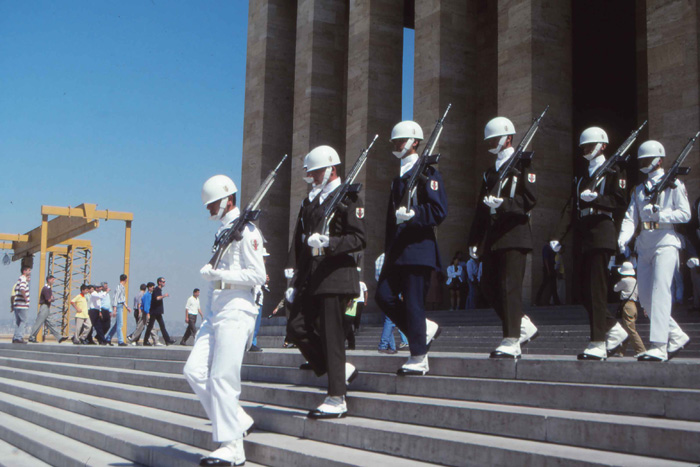
Six honorary guards begin a ceremonial march in front of Kemal Ataturk's landmark mausoleum in Ankara
Antikabir is a large mausoleum dedicated to Atatürk, the father of modern Turkey. We had once visited the home of his birth located on Apostolu Pavlou Street in Thessaloniki. Credited with transforming Turkey into a modern country and changing its difficult Arabic script into the Roman alphabet, Atatürk quickly became known as the father of modern Turkey. We stand together in astonishment below Antikabir, his hilltop mausoleum and museum overlooking the entire city. Twelve pairs of travertine lions line the broad approach to the museum. The enormous site features important displays of historical material and contains his burial tomb and many personal objects. A large portrait of Atakürk reveals his piercing blue eyes under bushy eyebrows. While he was a ruthless authoritarian, he did transform the country into a modern state, built a strong military, liberated women, provided free compulsory education and propelled the emergence of a large, secular middle class. Inside, we stroll past displays of his medals, personal effects and several official automobiles. "Do you think Turkey will be able to sustain his legacy in the years to come?" Eleanor asks. "Or will it slip back into religious fanaticism under a future leader? Above all, we must never forget how cruel and unrelenting Atatürk was as he consummated the Armenian genocide, nor how he played a major role in expelling the Greek population of Smyrna."
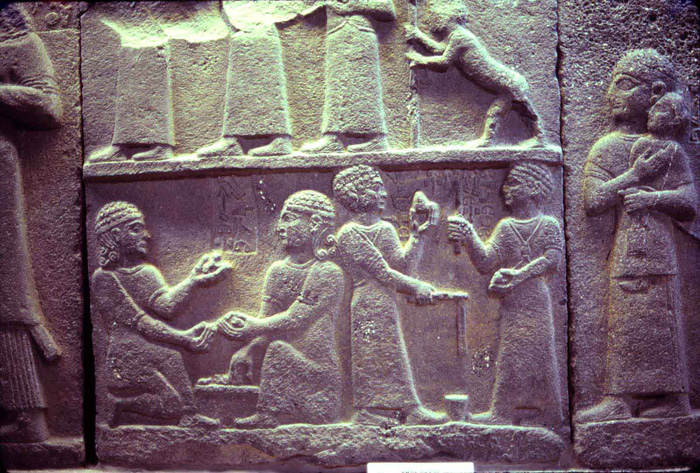
Among the many treasures in Ankara's Museum of Anatolian Civilizations, a Hittite frieze depicts daily life.
The Museum of Anatolian Civilizations, Ankara's second most visited site,
is housed in two Ottoman buildings near the Ankara Castle and is known
for a large collection of treasures ranging from Stone Age to Neoclassical.
Its sequential displays are meticulously organized and I can't wait to
view them up close. "All the pieces here come from within Turkey,"
says Ahmet. "Take your time, there is much to see." We all go
our separate ways. I gravitate toward several exhibits dating from the
13th Century BCE Hittite Period. There is a large bronze of a woman suckling
her baby and a bronze tablet with Akkadian script revealing a correspondence
between the wife of Ramses II of Egypt and a Hittite queen. Nearby, a
tumulus is a reproduction of the tomb of King Midas of Gordion. A real
showstopper is an interesting array of bronze fertility gods, bulls and
deer. In the late Hittite Period section, a chimera reveals its dual human
and lion heads. Every section is a showstopper. Ultimately, all of us
end up in the gift shop, where metal facsimiles of owls and bulls make
perfect gifts to bring home. "That was quite a museum," says
Bill as we pile into the van on our way to see more of Ankara. "One
of the best I have ever seen."
Throughout most of its history, Turkey has been home to many ethnic minorities, from Greeks and Jews to Armenians and Kurds. We are curious to see if anything remains of Ankara's old Jewish neighborhood. The earliest Jewish settlers, the Romaniotes, came during first century, but most came at the invitation of Sultan Mehmet who welcomed Jews expelled from Spain and Portugal during the Inquisition. "Sadly, I think you will see that almost everything in the Jewish community has vanished," says Ahmet. "Today any remaining Turkish Jews tend to live a sub rosa existence and we really don't know who they are. I would guess there are a few dozen Jews left in Ankara. One of the best maintained buildings is the old Sengal Hamam. Most other buildings are boarded up or torn down. When Israel became a state, many of Ankara's Jews quickly left." We finally stumble across an old synagogue, but it is virtually unrecognizable, hidden behind walls topped with barbed wire. "There are plans to restore it," Ahmet adds, "but it probably will only be open on rare occasions because of the difficulty in attracting the required minimum of ten men for holding a service."
"I am
going to drop you off at one of my favorite parts of Ankara, the colorful
Saman Pazan neighborhood," Ahmet announces. "It's a great area
for shopping and dining. You can easily get back to the hotel from there."
And so it is. Most of the shops and stalls exude a bazaar-like atmosphere:
copper ware, Anatolian rugs, bric a brac and a few upscale stores that
feature some of Turkey's hand-painted pottery, the legacy of the Iznik
tradition dating back hundreds of years. We stumble upon a large, round
platter that we can't resist. "When we return to Athens, I'll have
to make a trip the flea market for yet another carry-on cloth bag,"
my husband sighs, envisioning the packing challenges ahead. At a popular
restaurant frequented by Ankara's numerous government workers, we sample
several tangy salads and Iskender Kebabs slathered with tomato sauce and
sheep's yogurt. "Just delicious," Mary exclaims, a food enthusiast
like no other. "But let's order some karpouzi (watermelon) to cleanse
our palate," she insists. I have yet to remember any meal during
our travels together when Mary did not crave karpouzi.
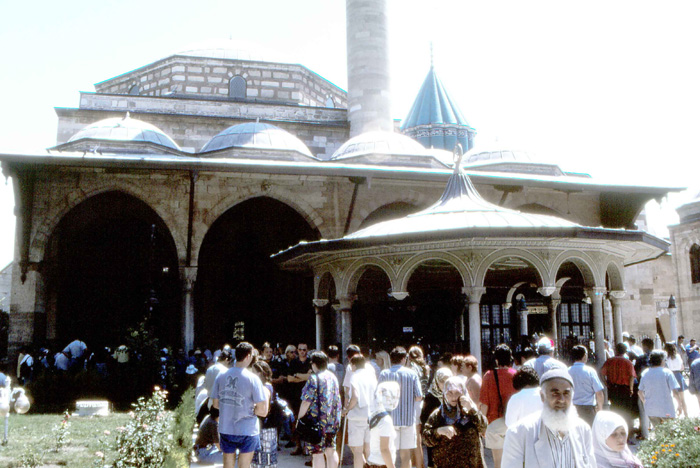
In the holy city of Konya, the Mevlana Museum attracts thousands of visitors each day.
"We will be stopping in Konya on our way to Göreme in Cappadoccia," Ahmet announces as Yusuf maneuvers the van out of Ankara in a southerly direction in mid-morning. "Konya was the capital of the Selcuk Empire from 1071-1368. You will immediately notice that it is a more conservative city, and many women cover their heads with scarves. Konya's main attraction is the tomb of the founder of the Mevlana order, Jalal al Din Rumi," Ahmet continues. "I will tell you more about him once we arrive." On our earlier trip we actually stayed in Konya in a comfortable hotel with extra plush Turkish towels but with a traditional hole-in-the-floor toilet. "Remember how we used one towel to seal the bottom of the bathroom door to keep our room fresh?" I chuckle as I relate the story.
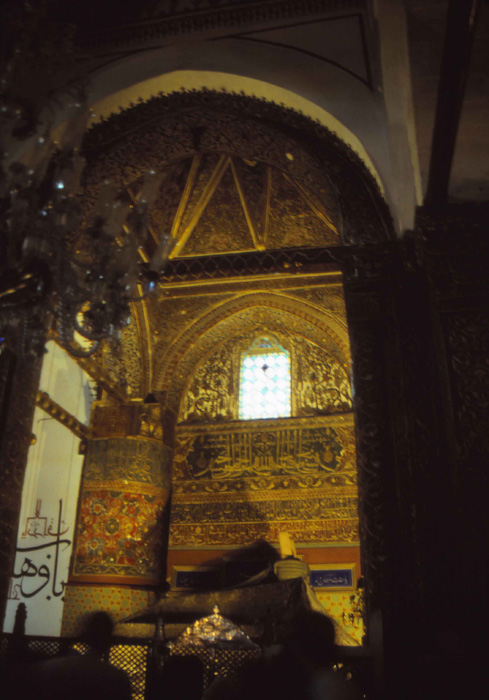
The tomb of Jalal al Din Rumi, the founder of the Mevlana Order,
sits under a green dome covered by an embroidered brocade.
We arrive at the Mevlana Museum and follow the regimen of the locals, washing our hands in a basin near the entrance and taking off our shoes, de rigueur prerequisites for entering inside. His sarcophagus is located under a green dome and is covered with an embroidered brocade that relates verses from the Koran. Apparently, Rumi's poetry transcends cultures and is known for his many aphorisms. He preached tolerance, forgiveness and gratitude and remains a powerful force in modern culture. As a Sufi mystic, he especially found ecstasy in dancing. "His dancing is the basis of the whirling dervishes who spin round and round, one arm raised to God." Ahmet explains. "The dancing serves as a portal between the earthly and cosmic worlds. When we get to Cappadocia, we will go to a special performance where you can see the dervishes up close."
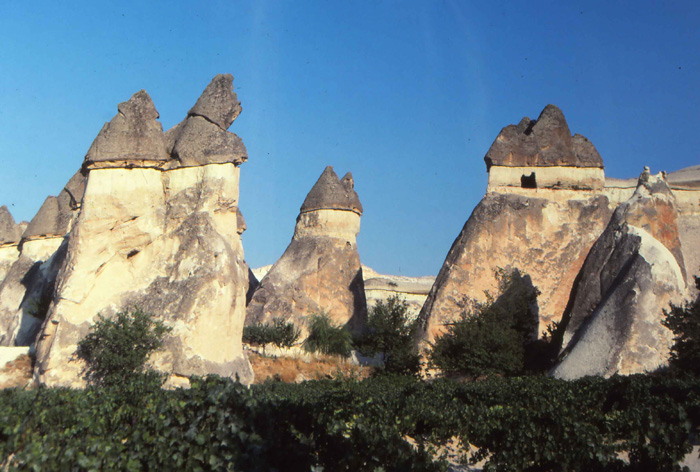
Cappadocia is a land of fairy chimneys and rock caves formed by the erosion of layers of lava over the millennia.
No other landscape on earth resembles Cappadocia. The region dates back 60 million years to the violent eruption of Mount Erciyes, Mount Hasan and Mount Melendiz which covered the region with enormous amounts of thick, soft layers of lava. Millennia after millennia, wind and rain ate away at the lava which had hardened, sculpting the rocks into unusual shapes, some crowned with mushroom-like "hats." These rocky outcrops were easy to carve and became cave dwellings. Others were turned into churches. During the seventh century, persecuted Christians dug deep into the tufa layers, creating two elaborate underground cities with as many as eight levels of habitable space including residences, chapels, kitchens, eateries and even jails. "We will be visiting the underground city of Derinkuyu on one of our days here," Ahmet announces, "as long as you are not claustrophobic."
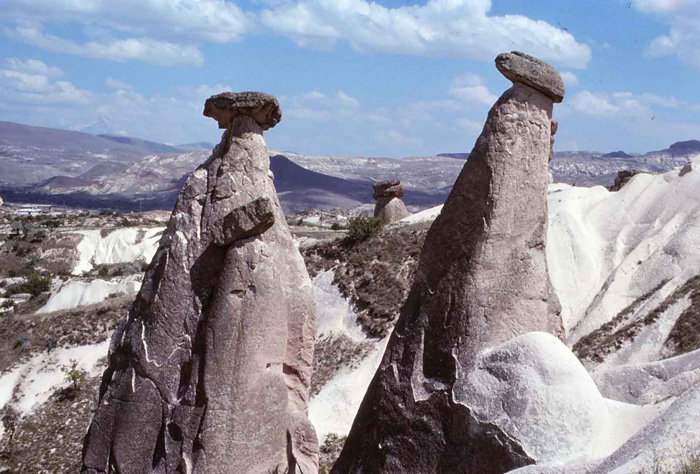
Flat rocks crown some of Cappadocia's spires, as if purposefully placed there by a wizard.
It is late afternoon as we approach the village of Göreme, Cappadocia's main tourist center dotted with a variety of hotels, restaurants, handicraft emporiums, and a line-up of well-preserved Byzantine cave churches. We check into a large modern hotel, an upscale property with swimming pool, restaurant and a convenient location near local attractions. Göreme is also becoming a nexus for a burgeoning balloon ride industry that is attracting more visitors. Viewed from high in the sky, the town becomes a de facto open air museum with its bounty of plush cave hotels carved right into the rock face and its surreal rock spires. Nearby are the two underground cities that Ahmet described, offering a fascinating glimpse into human resourcefulness during very dangerous times. Most of Goreme's churches and refuges are hidden, shielding a bounty of vivid frescoes and unusual icons that have been well protected. These relics of monastic life would go on to play a major role in the development of the Greek Orthodox Church.
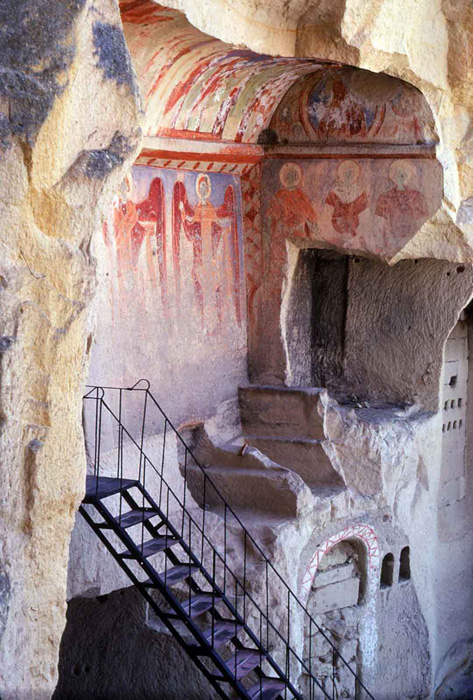
Early Christians who populated Göreme created beautifully frescoed cave churches.
The next morning, we explore one such cave church and are totally blown
away by its well-preserved wall frescoes, some appearing if they were
painted only yesterday. Mary, a devout church goer, is visibly excited,
as if she has been especially blessed by these centuries-old icons and
heading closer to salvation. We continue on a grand outdoor tour of the
Göreme Historical National Park, a Disneyland in stone and a UNESCO
World Heritage Site since 1985. It's hard to know where to look first:
Some of its vertical formations have conical hats, others are crowned
with disk-like platters, still others resemble mushrooms and a few appear
to be downright phallic. All are created out of "volcanoclastic"
rock which solidified over time into "tuff," with wind and water
erosion adding the final sculpting, creating unexpected shapes. Moreover,
the soft cliffs and rocky outcrops are also easy to hollow out and were
often transformed into dwellings that today have morphed into Göreme's
endless lineup of cave hotels. I am sure that this phantasmagoric terrain
is even more enchanting when viewed from a balloon floating above it.
But Elinor and Mary are balloon-phobic, so we opt out.
In the evening,
on our way to a whirling dervish performance that is staged nightly at
the Saruhan Caravanserai, we make a brief detour at a hillock named Aydin
Kiragi, renowned for its panoramic views of the sun sinking over the rock
formations. The caravanserai is located on the Avanos-Göreme Road,
one of many such Seljuk inns that were stops along the historic Silk Road
linking Anatolia to India and China. A caravanserai was the motel of its
day, built around a central courtyard with rooms for travelers, facilities
for their camels or horses, a hammam for bathing and relaxation, enough
food for sustenance and a chance to rest and unwind. Unfortunately, my
husband is a bit under the weather and has stayed behind at the hotel.
The rest of us take seats on the floor at the edge of the dance floor
and wait for show to start. Four male dancers in flowing white tunics
and conical hats enter the designated performance space and begin to whirl
in one direction to eerie music generated by a ney (reed flute). With
their right hand extended up toward heaven, their faces immobile, the
dancers continue to spin non-stop for nearly 20 minutes. Their graceful
whirling is astonishing and they seem to have entered a trance. A master-singer
begins to chant, praising Allah in a mishmash of Turkish, Farci and Arabic.
Their non-stop spinning works up a genuine sweat, but the dervishes continue
on for about ten minutes more until finally a crescendo is reached in
the music and they stop and bow. "Just amazing. Somehow, they manage
not to get dizzy," Bill mutters as we leave. "Too bad we were
not allowed to take photos."
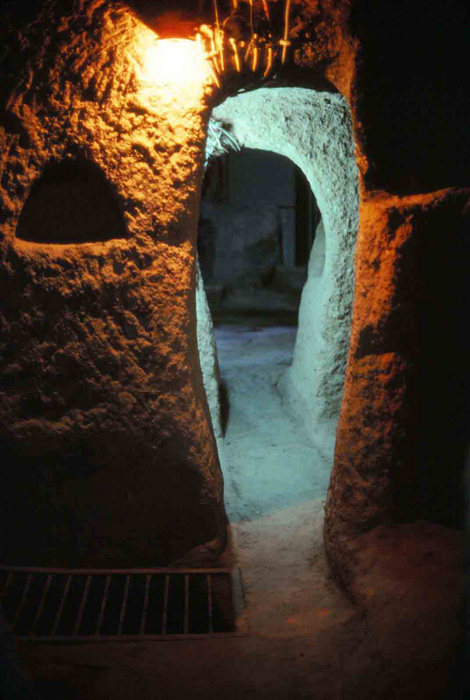
Derinkuyu is an eight level underground city complete with living quarters, wine cellars,
a chapel and kitchens with long shafts to channel smoke far away.
Early in the morning we head out to the underground city of Derinkuyu
for a fascinating glimpse into human resourcefulness. I am relieved that
each subterranean level--the lowest reaching a depth of 85 meters--is
well illuminated and that there are plenty of hand rails to grab onto.
Sleeping and sitting areas are carved right into the walls, but connecting
passageways are quite narrow. There are wine cellars and storage areas,
a chapel for worship, and kitchens with hearths whose smoke is channeled
down long shafts to be expelled far away from the settlement via an unobtrusive
exhaust opening. The latter was also a practical defensive strategy for
Christians who hid out in the city. Their clever engineering provided
no hints that humans were living underground and as a result they were
able to survive in relative peace and comfort, having stashed away enough
food and water to last for months at a time!
The area
of Avanos, not from the heart of Göreme, is renowned for its outstanding
ceramics shops, many of which are situated underground. The town is a
major pottery center due to the availability of suitable clay from the
Kizilirmak River. Among the lineup of shops, Chez Hakan is a rambling
emporium now in its third generation of family potters who create exceptional
pieces in a variety of styles, including museum-quality replicas of Kutahya
ceramics dating from the Ottoman period that are in the Topkapi Palace
collection in Istanbul. We have a field day! And, yes, dear reader, you
guessed it! We will be purchasing a second cloth bag in Athens to hand-carry
a magnificent platter, wrapped in multiple layers of bubble wrap and carefully
placed in the plane's overheard bin!''
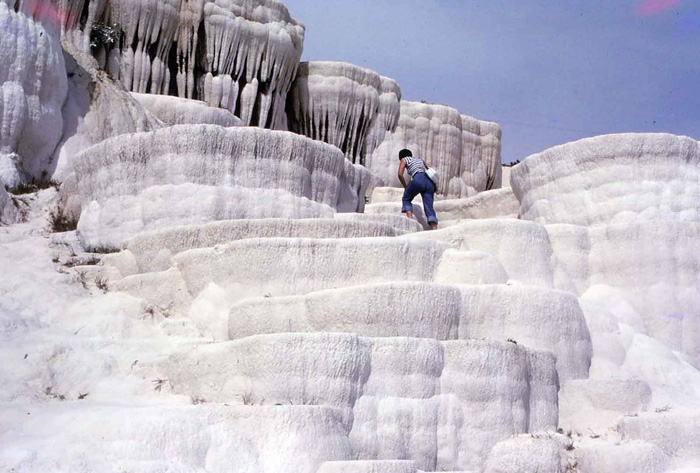
Pamukkale's travertine terraces and cascading thermal waters are a UNESCO World Heritage Site.
Yusuf signals that we must head out if we want to arrive at Pamukkale in time to enjoy its mineral waters. By late afternoon, we find ourselves in the western province of Denizli, not far from the Aegean coast, the warm sun still beating down on the site's glinting travertine terraces as thermal waters cascade over them. One of the world's most remarkable natural spas, it has been declared a UNESCO World Heritage Site and the use of its natural pools is carefully controlled. Nearby is the ancient site of Aphrodisias, a cult city dedicated to Aphrodite and only discovered by archaeologists in 1974. "Pamukkale is unique in the world," Ahmet explains, "but it has a fragile ecosystem that must be protected. Its name means cotton castle, because cotton was once grown nearby. Accordingly, Turkey is famed for its dense cotton towels that rank as the world's very best." After checking in at a nearby hotel, we spend about an hour frolicking in the hotel's pool which is filled with water from Pamukkale's springs. In the morning, a quick survey of the Aphrodisias site makes me wish I were an archaeologist. Built on the bones of a Greek city dating from 190 BCE, it later became a Roman stronghold known for its remarkable theater during the reign of Septimius Severus. It contains a sizable necropolis with several unusual sarcophagi. Here, too, gladiator games were held, and the Apostle Phillip was martyred and buried. Excavations are still in early stages and the site promises a bounty of riches to be revealed. "What an archaeological gem," we all agree as we head out in the direction of Antalya, Turkey's largest resort city and gateway to the Turquoise Coast.
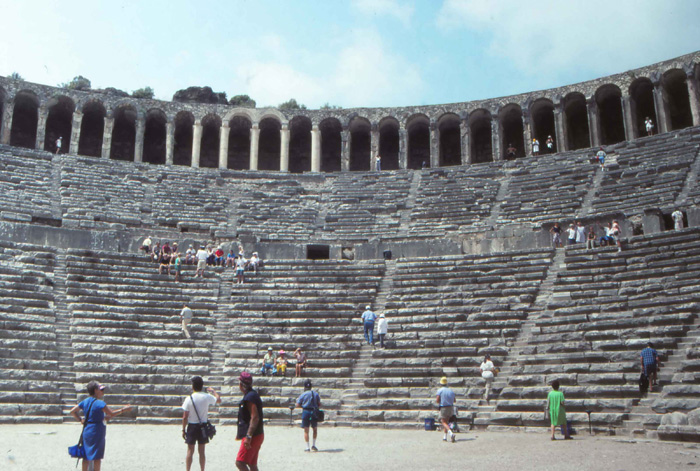
Ancient Hierapolis eventually became a Roman stronghold known for its remarkable theater.
"How about some lunch?" Ahmet suggests. Yusuf turns into the parking lot at Botanik, a popular outdoor restaurant located in Ulupinar in Antalya Province and set next a river known for its fresh trout and other seafood. You can fish for your own lunch at the river, or let the pros do it for you. We find an empty wooden table under leafy shade and await for our order to be grilled. It is a remarkable feast in a peaceful setting unlike any other we have ever experienced, with rushing waterfalls that spill into the river and birds chirping in the trees. Several shops located on the premises display a wide variety of locally-made handicrafts. "Turkey sure has its hospitality act together," says my husband as he contentedly sits back on his chair for a quick nap.
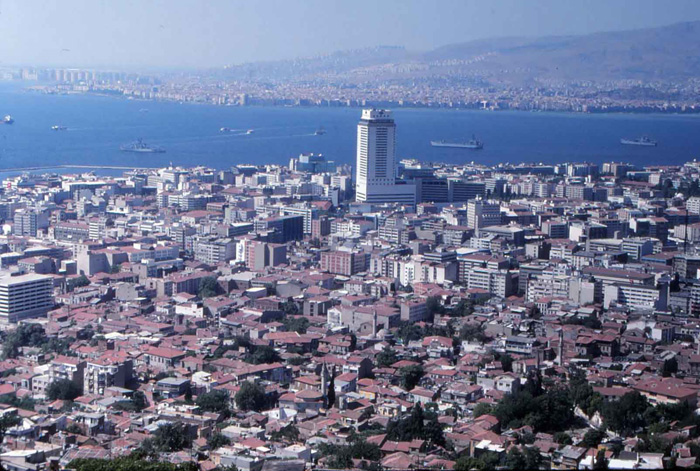
Antalya is a major tourist hub on Turkey's breathtaking Turquoise coast.
Antalya is dotted with numerous seaside resort hotels and villas that
service tour groups from the Middle East, Europe, the Balkans and elsewhere.
We check into the Buyuk Efeis Hotel, a large property not far from the
beach and especially popular with Israeli and Russian tourists. Here,
in-room movies are dubbed in Hebrew and Russian. Ahmet and Yusuf are waiting
to take us on an afternoon spin around the city and a visit to its impressive
archaeological museum. In the Classic Period Hall, we linger in front
of a well-preserved sarcophagus depicting the twelve labors of Hercules.
An adjoining statuary hall is jammed with marble busts and standing gods
from the Roman pantheon, including Minerva, Jupiter, Venus and Diana.
In Antalya's cobbled old town, we pause to admire the fluted minaret of
Yivli Minare Mosque, dating from 1372 and the city's iconic landmark.
It is the gateway to a series of twisted lanes, jam-packed with quality
antique and craft shops. We sit for a good hour right on the floor of
an especially fine shop and sift through stack after stack of small Kutahya-style
fluted plates, each painted with a different configuration of tulips,
the classic Ottoman flower. Satisfied that we have enough plates to serve
a dozen people, we have them carefully packed in bubble wrap. "These
will fit in between layers of clothes," I assure my husband who by
now is in his pottery-overload panic mode. We continue to Antalya's historic
harbor where dozens of yachts are docked. The scent of grilled fish wafts
out of several eateries packed with noisy patrons having a rollicking
good time. "Shall we grab a bite," I suggest. "By all means,"
Elinor smiles.
It's a perfect morning without a cloud in the sky. Ahmet and Yusuf take us on a journey to Aspendos, the world's best preserved ancient theater. The work of the great Greek architect, Zenon, it fell under the sequential control of Lydians, Persians, Athenians, Alexander the Great, Romans, and ultimately, the Ottoman Empire. "This theater can accommodate up to 12,000 spectators and often becomes a concert venue." Ahmet explains. All five of us are blown away. "It is a thrill to attend a live performance here," he adds. We continue to Perge, once an important Hellenistic city situated near two rivers and containing an old Roman cardo lined with columns. I fixate on a graceful lintel supported by two delicate Ionic columns and remnants of statuary near a massive fountain. "We will be taking you to a restaurant with live Turkish folk music tonight," Ahmet discloses on the return drive to Antalya."
Hours later, sated and smiling after an exemplary Turkish dinner, Mary's eyes suddenly ignite as two dancers come out to perform the dance of the Zeybeks, a precursor of the popular Greek male dance, zeibékiko. The costumed dancers add special flourishes and gestures once they notice that we are a very receptive audience. In Greece, this dance has evolved into something else. There are no set steps nor any routine, just movement inspired by the mood of the dancer and the rhythm set by the music. The modern zeibékiko becomes a way for a male to express his inner feelings, his angst and his joy, often evoking old traditions rooted in Asia Minor and a homeland lost long ago.
In the morning we board a luxurious air-conditioned bus with assigned seats headed to Izmir (also known as Smyrna), having thanked Ahmet and Yusuf repeatedly for an outstanding tour that was jam-packed with extras and filled with insight. "You must come to America one day," we wave as the bus finally pulls away. In Izmir, Mary immediately sets out to explore an old neighborhood once populated by Asia Minor Greeks, and possibly some of her ancestors. I put in a phone call to Despina, the mother of our close Philadelphia friend, Nikos Stefanidis. Despina, who spends a good part he year in the U.S. to be with her family, lives in Chios during summer months in the village of Kallimasiá. She is expecting our visit and looking forward to it. As we make the quick crossing from Cesme, I muse. We have finally come full circle. On our first trip to Turkey in 1978, we crossed over to Turkey from Chios!
In Chios
it is slow going through passport control, but finding a taxi to take
us to the village of Kallimasiá is no problem. Despina welcomes
us with open arms and shows us our guest rooms. Her hospitality is boundless
and she can't do enough to make us feel at home. I recall another visit
in 1985, when we unexpectedly ended up in Chios during the busy August
season with my mother and children. Despina regaled us with a wonderful
dinner and the best French fries we had ever eaten. "Ach! It's so
good to be back in Greece," says Mary as we explore the village and
visit an embroidery workshop known for its exquisite table linens. Unfortunately,
Bill is feeling under the weather and wants to return to Athens. "We'll
visit the doctor and then head to our house in Sifnos so Bill can rest,'"
Mary explains.
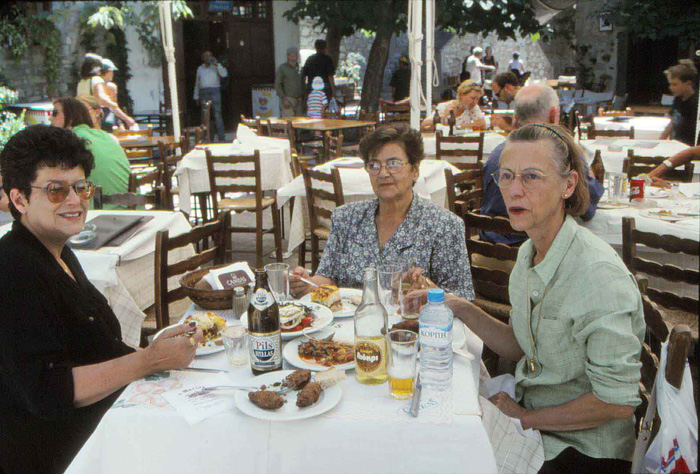
Despina joins us for a delicious lunch at Mesaionas in Mestá, a traditional mastic village in Chios.
The three of us are happy to stay on and immediately rent a car so we can explore more of the island. Despina joins us on all our outings and is loving the companionship. "Théloume na ta doúme óla (we want to see everything)," I tell her. Top on our list are the mastic villages of Pyrgí and Mestá. It's a balmy summer morning as we head out to these two timeless settlements, where the architecture is unique and local women sit on door stoops, gossiping and stringing tomatoes to hang from balconies, or trimming green beans for fasolákia latherá, a delectable green bean stew. In Mestá, we descend the stairs behind Mégas Taxiárchis, the biggest church on the island, and stop for lunch at Mesaionas, a family-run restaurant. "Our pastítsio is made from secret recipe," the waiter brags. We each order a slice and a salad to share. At the end of meal, he surprises us with three tiny glasses filled with souma, a potent liqueur made out of figs and the traditional island drink for special occasions. "Tou chrónou (to next year)," we all hold up our glasses!
